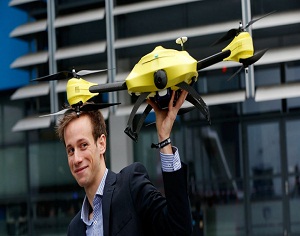By Sasha Pei-Silovo – EM TV Online
A 23 year old graduate student at the Delft University of Technology, Alec Momont, has designed an ambulance drone “designed to save lives by reducing response times to medical emergencies.”
Delft University of Technology, also known as TU Delft, is the largest and oldest Dutch public technical university, located in Delft, Netherlands.
The drone is a compact flying ‘medical toolbox’, which carries essential medical equipment that anybody can use. This first prototype has been designed to transport a defibrillator.
The unmanned, autonomously navigating mini aeroplane can deliver a defibrillator to wherever it is needed; with a network of drones as such, there could possibly be an increase in ‘chance of survival’ following cardiac arrest. Momont’s drone can quickly reach heart attack victims, in minutes, at flying speeds for up to 100 kilometres per hour (60 miles per hour).
“Some 800,000 people suffer a cardiac arrest in the EU every year, and only 8% survive.
“The main reason for this is the relatively long response time of the emergency services (approx. 10 minutes), while brain death and fatalities occur within 4 to 6 minutes. The ambulance drone can get a defibrillator to a patient inside a 12 km2 zone within one minute. This response speed increases the chance of survival following a cardiac arrest from 8% to 80%”, Momont explains.
From the university’s Faculty of Industrial Design Engineering, Momont designed the prototype for his ambulance drone, along with the ‘living tomorrow innovation platform’ as part of his graduation programme.
The ambulance drone is equipped with a video and audio connection that allows for medical professionals to give instructions to those ‘on ground’, nearest to the victim, until paramedics arrive at the scene.
‘It is essential that the right medical care is provided within the first few minutes of a cardiac arrest. If we can get to an emergency scene faster we can save many lives and facilitate the recovery of many patients.
“This especially applies to emergencies such as heart failure, drownings, traumas and respiratory problems, and it has become possible because life-saving technologies, such as a defibrillator, can now be designed small enough to be transported by a drone”, says Alec Momont.
So how does it work? Quite simple really: when the emergency service receives a cardiac arrest call, this unmanned, autonomously navigating mini aeroplane (ambulance drone) can quickly deliver a defibrillator to the scene of emergency.
Via livestream video and audio connection, the ambulance drone provides feedback directly to the emergency service and the persons at the scene of emergency (where the cardiac arrest victim is) can be instructed on how to treat the patient whilst paramedics rush their way over.
The drone finds the patient’s location through the caller’s (person reporting emergency) mobile phone signal and using GPS, the ambulance drone flies its way to the scene.
The drone weighs four kilograms, and can carry a further weight of four kilograms.
It has yet to be ‘adopted’ by medical emergency services but it has been reported that authorities in Amsterdam have shown interest.
The ambulance drone is most likely to cost around $22, 500 US dollars equivalent to 14, 050 Euros.
Credit: Delft University of Technology
https://youtube.com/watch?v=y-rEI4bezWc%3Ffeature%3Doembed%26wmode%3Dopaque%26showinfo%3D0%26showsearch%3D0%26rel%3D0


